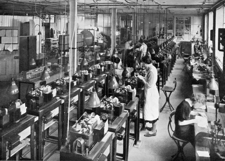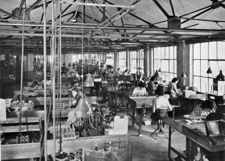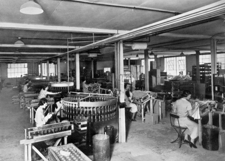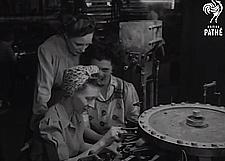|
|
|
Introduction
The precise date of opening of the Angel Road factory of Atlas Lamp Works is not known, but in 1932 it was taken over as the first manufacturing venture in what later grew to be the vast Thorn Lighting company - at one time the largest lamp manufacturer in Britain as well as one of the top ten of the world. The company grew with incredible speed, taking over its larger competitors as well as establishing its own more modern prodcution facilities. Eventually the original Edmonton site was dwarfed by Thorn's enormous expansion, and no longer required. The factory was closed in the mid 1960s with the majority of its production being transferred to Merthyr Tydfil and Kent Street, Preston.. |
 Atlas Lamp Works, Angel Road, Edmonton
Atlas Lamp Works, Angel Road, Edmonton
|
| Address |
402 Angel Road, Edmonton, United Kingdom. |
| Location |
Unknown
|
| Opened |
Pre-1932 |
| Closed |
1964-67 |
| Products |
Incandescent lamps of all types |
Origins of the Thorn Lighting Business
On 6th February 1899 Jules Thorn was born in Vienna to Jewish parents, and after returning from military service in the first world war, studied at the Handelshochschule (Business School) in that city. On completion of his studies he started working for Olso, an Austrian manufacturer of gas mantles which later diversified into incandescent lamps, and in 1923 he moved to the United Kingdom as the representative for that company. Just three years later Olso had gone bankrupt, and whereas many others would simply have returned home, Thorn felt indebted to his loyal customers and remained in Britain to try and pay off the debts his former company owed. In the mean time he had built up a sound understanding and passion for the electric lamps market and made two decisions which were to shape the rest of his life : firstly, that he would make his home in Britain, and secondly, that it was possible to walk in underneath the gigantic worldwide electric lamp cartel, and make ample profits by selling at prices below the ring of controlled manufacturers.
At the time the global incandescent lamp market was rigidly controlled by Phoebus, a powerful industry association established by General Electric of America which revolved around that company's patents on incandescent lamps, manufacturing equipment and processes, as well as the supply of specialised raw materials needed in lampmaking. Companies who joined the cartel received access to these three critical inputs, but in exchange had their market share, sales territories and selling prices strictly fixed in order to prevent them from competing too hard against GE. A short life policy was also enforced in which manufacturers were forbidden from increasing their strength by selling lamps having a lifetime longer than 1000 hours, so as to ensure that the entire controlled industry benefitted from continued high sales volumes and as a result the generation of significant royalties and profit margins. A few small manufacturers managed to survive outside the ring by finding alternative supplies of the specialised lamp components, and avoiding use of key patents. This was relatively difficult because the alternative materials and manufacturing methods inevitably carried a higher cost than the Phoebus members could enjoy - but such was the financial greed of the cartel in respect to its astronomical selling prices, that in some countries there was still just enough room for the most efficient of the smaller players to sell their more expensive lamps at below-ring prices and still make a healthy profit. Phoebus of course tried to fight these companies hard, forcing them one by one to succumb into joining the cartel, or if they resisted, to attempt to force them out of business. Taking control of component supplies and cutting those off was one particularly successful way of crushing the independents.
Owing to his language skills and awareness of the lamp supply situation in his home territory of the Austro-Hungarian Empire, Thorn established contact with the Hungarian Tungsram company and was able to benefit from the fact that the Cartel fixed prices locally, for each geographical region, and that the Hungarian lamps were considerably cheaper than those sold in Britain. On 29th March 1928 he set up "The Electric Lamp Service Co. Ltd." to import those into Britain and sell below the ring prices to any wholesalers and end users who dared to defy the pervasive power of the traditional big lighting manufacturers. Unsurprisingly his business grew at phenomenal pace, but at the time of the Great Depression in the early 1930s, the British Government imposed heavy import duties, so as to protect its own local manufacturers. This impacted Thorn severely, and forced him to search for a British supplier. This he found in the Atlas Lamp Works of Angel Road, Edmonton which was one of the small independents still managing to survive on its own. However, in 1932, Thorn once again faced problems when it became known that ELMA, the Electric Lamp Manufacturer's Association and the British arm of the cartel, intended absorb Atlas.
|
Start of Manufacturing
Faced with inevitable extinction, Thorn went to the City of London looking for investment to fund what then seemed to be the crazy idea of establishing his own manufacturing operations in Britain, and taking over Atlas. Despite his already sound base of committed customers and personal beliefs that he could find a way to go head-to-head against the controlled companies, he was strongly advised not to proceed because GE's cartel was simply too strong and would crush any attempt to fight against its phenomenal power. In typical fashion of this devoted entrepreneur, who had already proven time and time again that he could sniff out opportunities that his competitors failed to spot and swoop in before they had time to react, Thorn ignored the advice and bought Atlas.
It is not clear precisely when that company was founded, and is only referenced that it was a small manufacturer in trouble because it was being forced out of business by the Ring. But Jules Thorn had a plan though and believed that he could turn the operation around into a successful business. Everyone in the City continued to regard Thorn as a psychopath to want to start making lamps - but at the end of the first year he incredibly proved himself by making a sound profit of £30,000!
|
Further Growth
Part of the reason for Thorn's success was his clear recogntion from an early stage that lampmaking is not only about physically assembling the lamp itself - this on its own is indeed useless without a sound understanding and cost-effective supply of the specialised component materials that are required, as well as excellence in manufacturing processes and machinery to keep the production costs as low as possible. The Lamp Ring also recognised that for its own survival, it was essential to control the supply of components and machinery, and one-by-one it vertically integrated itself by taking over and absorbing, or closing down the independent component and machine makers. By the 1930s that process had been virtually completed at least in Britain, as well as many other countries of importance, and is one of the reasons why Atlas would have been facing extinction.
Although it is not documented, it is likely that Thorn's central European connections would have introduced him to some of the remaining independent component manufacturers, and that following the takeover of Atlas Lamp Works he would have been able to draw on those supplies to enable his production. But in order to stay one step ahead of the ring, his clear understanding of the lamps business is demonstrated by the swift decision to establish his own component and equipment manufacturing, and avoid that he should be threatened once again by the international lamp cartel. In the following years, the Edmonton operations were expanded to include numerous highly efficient component material operations. For instance on nearby Commercial Road, Lamp Presscaps Ltd. was set up to produce the specialised metal caps needed for lamps. At the time these components were only available from the Controlled Manufacturers, such as Lamp Caps Ltd. of Chesterfield, an associated company of BTH and GEC, both of whom were members of Phoebus and would not sell caps at fair prices to the Independents. Similarly, Thorn needed Argon gas to fill his lamps and the only distillation plants in Europe at that time were at Philips Eindhoven, and Osram-GEC of Hammersmith, both of whom were also part of the lamp ring. He therefore established Thorn Cryostill Ltd. on nearby Argon Road, Edmonton, to produce his own gas - a division which was later sold off to the British Oxygen Company once other commercial applications for argon gas had become popular. Manifold Machinery, for the design and building of lampmaking equipment was also swiftly acquired and added to the Thorn portfolio.
The Edmonton lampworks went from strength to strength, quickly expanding its product portfolio to cover the entire gamut of incandescent lamps for general illumination purposes. Projection and special lamps also soon arrived, particularly during the Second World War when the government had to allocate which factories would produce which products. Thorn's manufacturing operations were found to be impressively efficient by comparison with the big established lamp companies, and Atlas was selected to produce a wide range of special new lamps as well as a plethora of different radio valves and specialised military electronic components via other divisions of the Thorn organisation.
In 1947 Jules Thorn was visiting America in search of a new product. He found it in fluorescent lamps and fittings. Even though the lamp cartels had largely been broken up by that time, powerful international patents still made it a formidable challenge to enter the fluorescent lamp business. Thorn met another small independent company who had started operations fighting against the ring, Sylvania Electric, and that company had stamped out a strong position for itself in fluorescent lamps that did not infringe the GE patents. Thorn came home with a 15-year deal in his pocket, in which Sylvania took a 20% shareholding in Thorn and the two companies formed a full technical interchange agreement on lamps and manufacturing equipment. With access to the prized fluorescent technology, Thorn proceeded in 1948 to build a new factory at Enfield and equipped it with what was at the time the best machinery in Europe for the manufacture of fluorescent lamps. Similar investments were made in Fluorescent Luminaires, and upgrading the incandescent manufacturing equipment according to new high-speed designs that had been developed by Sylvania.
|
End of Edmonton Lamps
1947 saw Thorn's first major diversification of incandescent manufacturing away from Edmonton, when to further cut his costs, the company took advantage of government subsidies to build a factory in the Welsh town of Merthyr Tydfil. The new Atlas Merthyr factory was equipped with the finest incandescent machinery available at that time, and inevitably competed formidably with the original Edmonton operations. The high volume manufacture of the ordinary GLS lamp types was swiftly displaced to Merthyr, while Edmonton continued making specialty types. The precise date of closure is not known, but is referenced as being during the period 1964-67 in the Government's Competition Commission Report into the Supply of Electric Lamps. The associated component factories in Edmonton were however retained for many years to come.
|
Photographs
|
 |
|
 |
|
 |
|
 |
|
| Part of Filament Spiralising Section |
|
Special Assembly & Filament Inspection |
|
Stem Making & Inserting Machines |
|
A Row of Capping Machines |
|
Factory Movies (7)
|
 |
|
|
|
|
|
|
| Merthyr Girls at Edmonton, 1946 |
|
|
|
|
|
|
Examples of Edmonton Lamps
|
 |
|
|
|
|
|
|
|
|
|
|
| Neon Coronation Lamp |
|
|
|
|
|
|
|
|
|
|
| 1 |
His Masters Voice : Thorn und EMI, Zwei Elektro-Unternehmen zwischen Unterhaltungsbranche und Rüstungstechnik, Kultur & Technik 4/1998 pp.19-25. |
| 2 |
From Making to Music - The History of Thorn EMI, S.A. Pandit, Hodder & Stoughton, 1996, |
| 3 |
The House that Jules Thorn Built, The Financial Times, December 1970. |
| 4 |
The First Sixty Years - A Photographic Record of Thorn Lighting Limited, Published by Thorn Lighting Public Affairs Department, 1988. |
| 5 |
The Monopolies and Restrictive Pratices Commission, Report on the Supply of Electric Lamps, 1968. |
| 6 |
Atlas Lamp Catalogue, 1940. |
| 7 |
British Pathé - Historic films of Osram. |
|
|
|
|
|